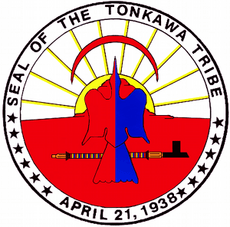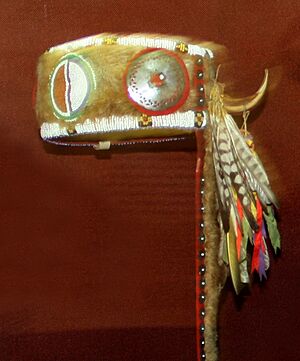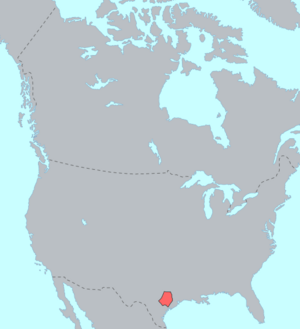Tonkawa facts for kids

Seal of the Tonkawa Tribe of Oklahoma
|
|
| Total population | |
|---|---|
| 611 | |
| Regions with significant populations | |
| Languages | |
| English, formerly Tonkawa language | |
| Religion | |
| Christianity, Native American Church, traditional tribal religions | |
| Related ethnic groups | |
| Wichita, Waco, Tawakoni, Kichai, Guichita |
The Tonkawa are a Native American tribe. They originally lived in what is now Oklahoma. Their language, called Tonkawa language, is now extinct. It was a unique language, not related to others.
Today, many Tonkawa people are part of the Tonkawa Tribe of Indians of Oklahoma. This tribe is officially recognized by the United States government.
Contents
Understanding the Tonkawa Name
The Tonkawa people call themselves Tickanwa•tic. This special name means "real people."
The name Tonkawa comes from the Waco tribe. Their word Tonkaweya means "they all stay together."
How the Tonkawa Tribe Earns Money
The Tonkawa tribe runs several businesses. These businesses bring in over $10 million each year. This money helps the tribe and its members.
They operate smoke shops and three casinos. These casinos are the Tonkawa Indian Casino and Tonkawa Gasino in Tonkawa, Oklahoma. The third is the Native Lights Casino in Newkirk, Oklahoma.
Important Tonkawa Events

The Tonkawa tribe holds an annual Powwow. This event takes place on the last weekend of June. It remembers a difficult time in their history.
The Powwow marks the end of their own Trail of Tears. This was when the tribe was forced to leave their traditional lands. They were moved to what is now Oklahoma.
A Look at Tonkawa History
For a long time, people thought the Tonkawa came from Central Texas. However, new studies show they lived in northwestern Oklahoma in 1601. By 1700, other tribes like the Apache and Wichita pushed them south. They moved to the Red River. This river now forms the border between Oklahoma and Texas.
In the 1500s, there were likely about 1,900 Tonkawa people. By the late 1600s, their numbers dropped to about 1,600. This was due to new diseases and fights with other tribes, especially the Apache.
In the 1740s, some Tonkawa joined other groups. They settled in the San Gabriel Missions in Texas. These missions were along the San Gabriel River.
In 1758, the Tonkawa and their allies attacked the Lipan Apache. They destroyed Mission Santa Cruz de San Sabá. Their allies included the Bidais, Caddos, Wichitas, Comanches, and Yojuanes.
The tribe kept moving south into Texas and northern Mexico. There, they became allies with the Lipan Apache.
In 1824, the Tonkawa made a treaty with Stephen F. Austin. They agreed to protect new American settlers from the Comanche. Austin was helping people move to the Mexican state of Coahuila y Texas.
The Tonkawa fought alongside the Texas Rangers. They fought against the Comanche in 1840 at the Battle of Plum Creek. They also fought in 1858 at the Battle of Little Robe Creek.
The Tonkawas often visited Austin, the capital city. This was during the time of the Republic of Texas and early statehood.
Relocation and Survival
In 1859, the United States moved the Tonkawa. They were moved with other Texas Indian tribes. Their new home was at the Wichita Agency in Indian Territory. They were protected by nearby Fort Cobb.
When the American Civil War began, soldiers left Fort Cobb. This left the tribes at the Wichita Agency unprotected.
Some pro-Union tribes attacked the Tonkawas. These tribes included the Delawares, Wichitas, and Penateka Comanches. This attack was partly due to old disagreements. The fight is known as the Tonkawa Massacre. Nearly half of the remaining Tonkawas were killed. Only a little over 100 people were left.
The tribe returned to Fort Griffin, Texas. They stayed there for the rest of the Civil War. In October 1884, the United States moved them again. This time, they went to the new Oakland Agency in northern Indian Territory. They have remained there since.
This journey involved a train ride from Cisco, Texas. The train took them to Stroud in Indian Territory. They spent the winter at the Sac and Fox Agency. The Tonkawas then traveled about 100 miles (160 km) to the Ponca Agency. They arrived at nearby Fort Oakland on June 30, 1885.
On October 21, 1891, the tribe signed an agreement. They accepted individual pieces of land. This was with the Cherokee Commission.
By 1921, only 34 tribal members were left. However, their numbers have grown since then. In the early 21st century, there are close to 700 Tonkawa members. The Tonkawa Tribe of Oklahoma officially formed in 1938. This was under the Oklahoma Indian Welfare Act.
Tonkawa Family Groups
The Tonkawa people were made up of several smaller groups. These groups are generally considered part of the Tonkawa:
- Awash
- Choyopan
- Haiwal
- Hatchuknni
- Kwesh
- Mayeye
- Nilhailai
- Ninchopen
- Pakani
- Pakhalateh
- Sanukh
- Talpkweyu
- Titskanwaticha
See also
 In Spanish: Tónkawa para niños
In Spanish: Tónkawa para niños


